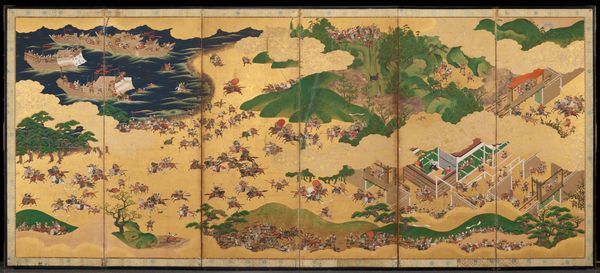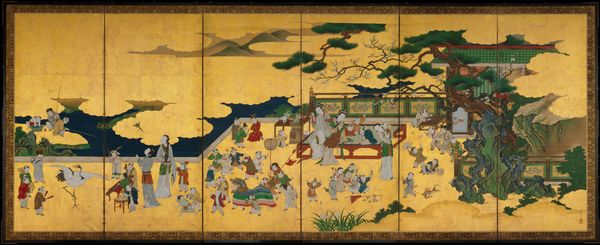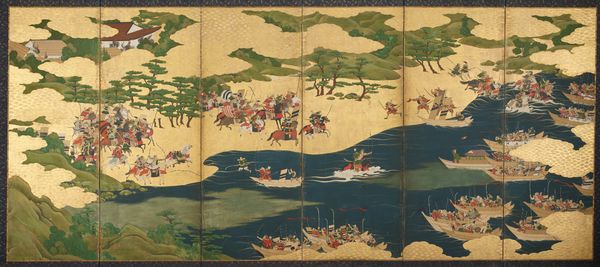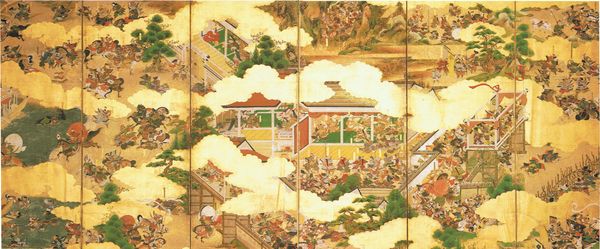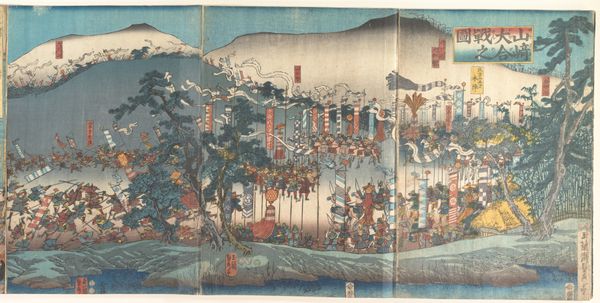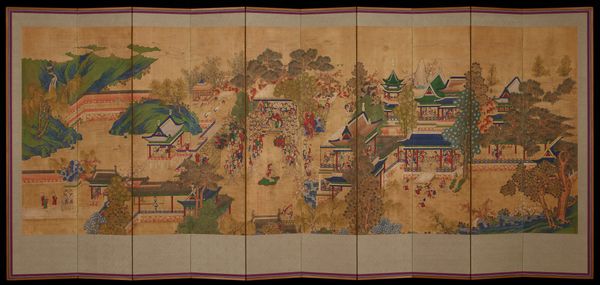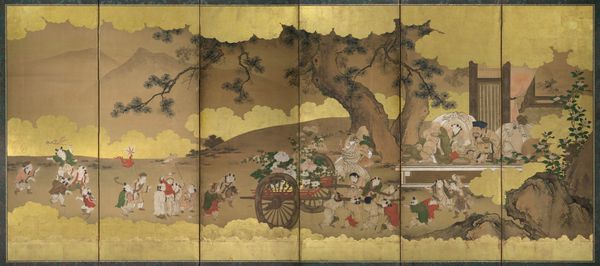![The Battle of Yashima [left of a pair of Scenes from The Tale of the Heike] by Tosa School](/_next/image?url=https%3A%2F%2Fd2w8kbdekdi1gv.cloudfront.net%2FeyJidWNrZXQiOiAiYXJ0ZXJhLWltYWdlcy1idWNrZXQiLCAia2V5IjogImFydHdvcmtzL2Y4Njc3N2I3LTA2YjUtNGZhMS1hOTliLWEwZjI1M2U1YjFkMC9mODY3NzdiNy0wNmI1LTRmYTEtYTk5Yi1hMGYyNTNlNWIxZDBfZnVsbC5qcGciLCAiZWRpdHMiOiB7InJlc2l6ZSI6IHsid2lkdGgiOiAxOTIwLCAiaGVpZ2h0IjogMTkyMCwgImZpdCI6ICJpbnNpZGUifX19&w=3840&q=75)
The Battle of Yashima [left of a pair of Scenes from The Tale of the Heike] c. mid 17th century
0:00
0:00
painting, watercolor, ink, mural
#
water colours
#
narrative-art
#
ink painting
#
painting
#
asian-art
#
landscape
#
japan
#
figuration
#
watercolor
#
ink
#
genre-painting
#
history-painting
#
mural
#
watercolor
#
yamato-e
Dimensions: 66 1/2 x 24 in. (168.91 x 60.96 cm) (each panel)
Copyright: Public Domain
Editor: So, here we have a section of a Japanese painted screen called *The Battle of Yashima,* from around the mid-17th century, attributed to the Tosa School. It’s done with ink and watercolor on what looks like gold leaf. All the little figures battling across this gilded landscape… It almost looks celebratory rather than mournful. What should viewers take away from a piece like this? Curator: Celebration isn’t necessarily inaccurate. Consider the sociopolitical landscape. Who would commission such a work, and why? Remembering that this depicts a key event from The Tale of the Heike – a foundational epic recounting the Genpei War – allows us to ask how the artist and their patrons used historical narrative. Are they seeking to legitimize a particular clan or champion certain values through this heroic retelling? What kind of gender and power dynamics are visible here? Editor: You mean, like how the individual warriors are presented? It’s hard to tell much about them as individuals. Curator: Exactly! Are they romanticized, heroic figures, or more like cogs in a machine? Also, notice the strategic deployment of empty gold space alongside areas of intense detail. How might that be playing into a larger symbolic understanding of power, absence, and presence? Consider the gendered and racial implications related to visibility/invisibility within Japan during the Edo period, especially when thinking about class and wealth. Editor: That's fascinating. So you're saying it’s not just about what's shown, but also what's intentionally left out or emphasized through composition that tells us more. The economics and history behind a scene like this really can change your view of it. Curator: Precisely! And questioning those choices allows us to connect it to larger conversations about history painting, national identity, and cultural memory. Thinking critically allows for deeper analysis, in this case concerning wealth, power and visibility. Editor: Thanks, that's given me a lot to consider! Curator: Absolutely. This painting serves as an exciting entry point for these crucial dialogues.
Comments
minneapolisinstituteofart almost 2 years ago
⋮
This pair of screens illustrates two decisive battles between the rival families of the Taira and Minamoto that occurred during the Genpei Wars (1180-1185). These epic clashes were recorded in the Heike monogatari (Tales of Heike), a semi-historical account written in the early 13th century that has inspired countless paintings and dramatic plays ever since. The battle of Ichinotani, on the right, illustrates Minamoto Yoshitsune's daring attack of the Taira camp. By leading his warriors in a mounted charge down a steep mountain at daybreak, Yoshitsune successfully took the Taira troops by surprise, forcing them to flee by ship. The left screen shows one of the most celebrated feats of martial skill in Japan's history. The Taira forces again fled by boat from the advancing Minamoto, shown here on the shore of Yashima. At dusk, a young woman appeared on the deck of one of the Taira ships and proceeded to perform a taunting dance with a red fan decorated with a rising sun. Yoichi Munetaka, one of the Minamoto's best archers, rode his horse into the shallows and shot the fan from the woman's hand at a distance of some ninety feet. This amazing feat was seen as prophetic, and indeed, the Taira were completely defeated about a month later. Typical of this kind of narrative painting, the artist used brilliant mineral pigments to render the landscape elements and figures in considerable detail. Gold clouds isolate individual vignettes, a device that also lends considerable opulence and decorative impact to the composition.
Join the conversation
Join millions of artists and users on Artera today and experience the ultimate creative platform.
